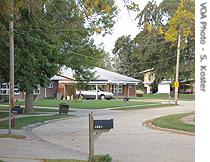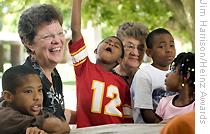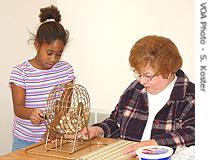-
(单词翻译:双击或拖选)
 |
| Hope Meadows resembles many American suburban1 neighborhoods |
The winding2 street lined with mailboxes and houses with manicured lawns looks like many residential3 neighborhoods in the United States. But Hope Meadows is unique. The planned community has a special mission: to support families who adopt children who, Brenda Eheart says, might otherwise never have families of their own: "sibling4 groups, older children, children with a lot of emotional problems - those children would probably remain in the revolving5 door of foster care if it were not for this program."
Helping6 foster families
The foster care system provides temporary homes for children who have been orphaned7 or removed from their birth families. Brenda Krause Eheart designed Hope Meadows based on her research, which showed that permanent adoptions8 of these children - some of whom had been abused or neglected by their birth parents - often failed, and the children were returned to foster care.
 |
| Brenda Eheart (left) with children and a senior resident of Hope Meadows |
"Our children have been in at least four different homes before they come to Hope Meadows, and some have been in seven and twelve homes," Eheart notes.
She believed that if families who adopted these children lived in a community together with specially9 trained counselors10 to assist them, the families would be better able to survive the challenges that faced them.
In 1994, Eheart was offered housing at a former military base to establish her planned community about 200 kilometers south of Chicago, in Rantoul, Illinois. But she was asked to fill more houses than she planned to.
Retirees key to success
That's when she decided11 to bring retirees into the mix. Although it wasn't part of her original plan, Eheart says, "That idea of having the seniors there, giving them reduced rent in exchange for their providing service and support to the community, has really been the one thing that has made this community the success that it is. I do believe we would have closed within three years without them."
Instead, Hope Meadows and the 12 families who live there are thriving. There are even plans underway to replicate12 the community elsewhere, thanks to a grant from the W.K. Kellogg Foundation.
New communities following model
Eheart believes that within the next two years, other inter-generational communities "will be popping up all over the U.S.," and some, she adds, will be addressing other social concerns.
She has already begun work in other states with young mothers who have completed a drug treatment program. "If they can go to a community where they can get affordable13 housing, where they can have grandparents, where they can get support while they learn job skills, learn parenting skills, they can have support through these relationships as well as their children," Eheart explains.
Elsewhere in the U.S., she says she is working with young mothers who have been in prison. She is also considering programs to support young people who have been convicted of crimes themselves and are coming out of the juvenile14 justice system.
Eheart, 64, grew up on a small dairy farm in the Midwestern U.S. She says values she learned from her hard-working parents, as much as her research into foster care, were guiding forces that helped shape Hope Meadows.
"My parents certainly did not have much money," she recalls, "but in troubled times my parents were always there, and my parents always sacrificed for the children."
Although her parents hadn't gone to college, she says they made sure all the children did. "And when I see children in a situation where they don't have that kind of caring adult in their lives, I almost have a visceral reaction to it."
 |
| Seniors and children play Bingo or other games after school at Hope Meadow's Inter- generational Center |
The 50 children who live in Hope Meadows - biological, adopted and foster - have not only supportive parents, but also a whole community looking out for them, including approximately 60 seniors.
Children help elderly neighbors
Eheart says the children have become caring individuals in return, caring for their elderly neighbors: "stopping by to make sure they are okay, calling them to make sure they are okay, bringing in their paper so they don't have to get up out of their chair, walking their dog for them day and night, [doing] all kinds of everyday things that would be difficult for the older adults."
Regardless of how old or how young we may be, we all want to be needed, says Brenda Eheart. At Hope Meadows, everyone is. It is a community of caring individuals on all levels.
"In some ways this is such common sense, and in some ways it's the way we would like to think this country could be," Eheart says. With Brenda Eheart's guidance it is becoming that way, one community at a time.
Her work was recently honored once again, this time with a $250,000 private award from the Heinz Family Foundation.
 收听单词发音
收听单词发音
1
suburban

|
|
| adj.城郊的,在郊区的 | |
参考例句: |
|
|
|
2
winding

|
|
| n.绕,缠,绕组,线圈 | |
参考例句: |
|
|
|
3
residential

|
|
| adj.提供住宿的;居住的;住宅的 | |
参考例句: |
|
|
|
4
sibling

|
|
| n.同胞手足(指兄、弟、姐或妹) | |
参考例句: |
|
|
|
5
revolving

|
|
| adj.旋转的,轮转式的;循环的v.(使)旋转( revolve的现在分词 );细想 | |
参考例句: |
|
|
|
6
helping

|
|
| n.食物的一份&adj.帮助人的,辅助的 | |
参考例句: |
|
|
|
7
orphaned

|
|
| [计][修]孤立 | |
参考例句: |
|
|
|
8
adoptions

|
|
| n.采用,收养( adoption的名词复数 ) | |
参考例句: |
|
|
|
9
specially

|
|
| adv.特定地;特殊地;明确地 | |
参考例句: |
|
|
|
10
counselors

|
|
| n.顾问( counselor的名词复数 );律师;(使馆等的)参赞;(协助学生解决问题的)指导老师 | |
参考例句: |
|
|
|
11
decided

|
|
| adj.决定了的,坚决的;明显的,明确的 | |
参考例句: |
|
|
|
12
replicate

|
|
| v.折叠,复制,模写;n.同样的样品;adj.转折的 | |
参考例句: |
|
|
|
13
affordable

|
|
| adj.支付得起的,不太昂贵的 | |
参考例句: |
|
|
|
14
juvenile

|
|
| n.青少年,少年读物;adj.青少年的,幼稚的 | |
参考例句: |
|
|
|















